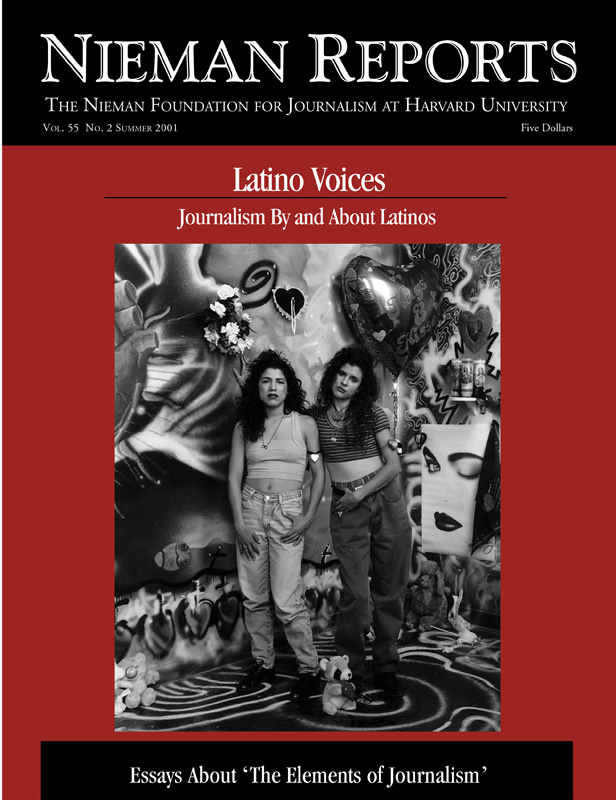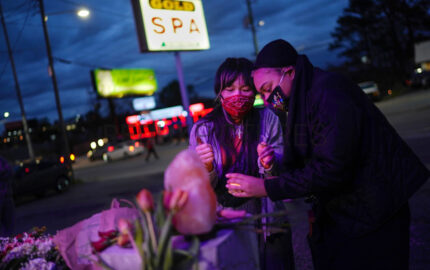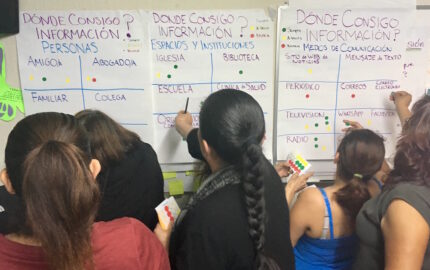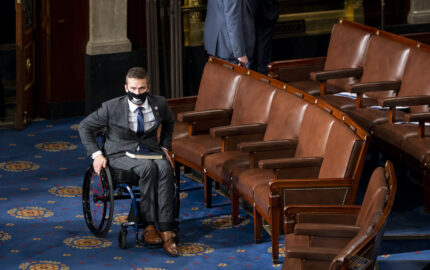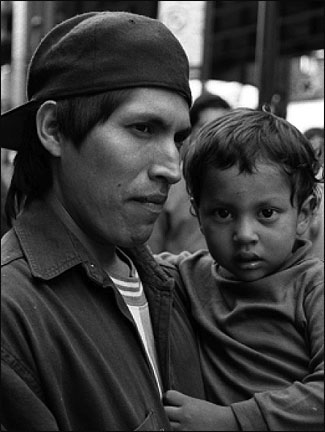
Photo by Alejandra Villa.
This is an historic issue of Nieman Reports, the first one written by and about Latino journalists. Some might say it took too long for this to happen, but as one who believes that, unfortunately, when it comes to diversity in American journalism we are witnessing an evolution not a revolution, I welcome this opportunity.
I am proud both as a Latina journalist and as a Nieman Fellow that these writers are being showcased here. This is just a small sample of the vitality, talent and creativity of my fellow Hispanic journalists. It is hard to believe that until a few decades ago, these voices were not part of the American print or broadcast media because of the de facto “apartheid” that existed in the nation’s newsrooms.
“Apartheid” might sound harsh, but consider this: Not too long ago I had a conversation with Félix Gutiérrez, a senior vice president of the Freedom Forum. He told me the poignant story of his father, Félix J. Gutiérrez, whose love of journalism and concerns about media portrayals of Hispanics led him, in the late 1930’s, to start a publication for Latino youth in the Southwest. During the 1940’s, after graduating from the University of California at Los Angeles, Gutiérrez was not able to pursue his dream of working for a mainstream publication. This was not for lack of trying. After his father died, Félix found in his files carefully kept records of his father’s attempts to secure a position with several Los Angeles area newspapers. He was never hired, and he decided to become an educator. The message then was unspoken, but understood nonetheless: “No person of color need apply.”
Unfortunately, this was not an isolated case. In subsequent years Latino journalists continued to be negligible in number, both in print and broadcast. That is why the case of Rubén Salazar is so remarkable. In the 1960’s, after working for papers in Texas and California, Salazar broke through the barriers and became first a reporter, then a foreign correspondent, and finally a columnist for the Los Angeles Times. A topnotch investigative reporter and an excellent writer, Salazar could and did cover any mainstream story, but on top of that he also brought a different perspective to reporting.
Salazar wrote with understanding about and respect for Mexican Americans and the Chicano movement. In doing so, he expanded and improved the quality of journalism as then practiced. His untimely death in 1970 while covering anti-war protests in East Los Angeles left a tremendous void. He also left a lasting legacy. To this day, young Latino reporters and editors point to him as the role model who inspired them to pursue journalism as a career.
The turmoil of the 1960’s opened some opportunity for journalists of color. I remember the late Nieman Curator Howard Simons telling us how in 1968, while still at The Washington Post, he “deputized” the African-American couriers to cover the aftermath of Martin Luther King, Jr.’s assassination, because there were no minority journalists at the Post at the time.
The picture was no better in broadcasting, but in 1969 the Federal Communications Commission (FCC) determined that it would not serve the public interest to grant licenses to broadcasters who engaged in discriminatory practices. The commission therefore prohibited licensees to discriminate in employment on the basis of race or sex and required them to establish Equal Employment Opportunity (EEO) programs. In the words of former FCC Chairman William A. Kennard, “It is no mere coincidence that the adoption of the EEO rules in 1969 was followed by a steady and very substantial increase among broadcasters in the percentage of jobs held by minorities and women.”
I know so, because in response to those regulations I was hired in 1971 by KNBC, the local NBC station in the Los Angeles area. I was the only Latina among a small group of young women selected for entry level positions in their public affairs and news departments, which at that time were mostly staffed by white males, who were not exactly welcoming. We had to put up with condescension and, in some cases, with outright hostility. We learned the hard way how to prove ourselves and, in the end, for those of us who prevailed, it was a great life lesson.
In those days there were so few Hispanics in local TV and newspapers in Los Angeles that even though we worked for competing outlets we formed a group: The California Chicano News Media Association. Here we found support. We got together socially. We started a scholarship fund. We advocated for an increased presence in the local newsrooms and for better coverage of our communities.
By the 1980’s we were more visible. Organizations like the National Association of Black Journalists, founded in 1975, the National Association of Hispanic Journalists, started in 1984, the Asian-American Journalists Association and the Native-American Journalists Associations, were raising their voices. And fueled in part by the still existing FCC regulations, broadcast organizations sent recruiters to our conventions and hired some journalists of color.
On the print side there was also some movement. The American Society of Newspaper Editors (ASNE) in 1978 started tracking the number of minorities in their newsrooms and set a goal: By the year 2000 they hoped to be able to match the percentage of minorities in the general population with those in their newsrooms. It was a worthy goal, but one that has proved elusive. In 1998 ASNE announced they were pushing the deadline to 2025. An even more troubling development came this year, when ASNE’s figures showed a slight decline in the number of minorities working in print, rather than progress toward meeting the diversity goal.
And what has happened in broadcasting? According to the Radio Television News Directors Association’s annual newsroom employment survey, in the year 2000 Latinos made up only four percent of all news directors and newsroom employees working at local English-language television stations. Spanish-speaking stations accounted for another three percent of Latinos in the overall broadcasting employment picture. Yet this year the U.S. District Court in Washington, D.C. threw out the FCC hiring guidelines, finding them “unconstitutional.” Those are the rules that opened the door for people like me.
But there is more bad news. This year, as media companies feel the pressure from their corporate owners to maintain high profits in a weakening economy, a wave of downsizing and cutbacks is further reducing employment opportunities and threatening to undermine the modest level of diversity achieved so far.
Contrast this with the recently released census figures. Latinos, if you include the population of Puerto Rico, are at 39.3 million, the largest minority group in the United States. From the standpoint of journalism, this news means that media organizations should be gearing up to accurately cover this significant segment of the American population. With the new reality of the role that business considerations seem to have these days in focusing editorial content, there is a case to be made in that regard as well. The Latino market—with a combined purchasing power of more than $350 billion dollars—is a dream for advertisers. It should be obvious to media companies that whoever delivers this group will profit greatly. However, there is no magic potion, no quick fix for grabbing the Latino market; it is not going to be accomplished in time for the next quarterly earnings report or the next ratings “sweeps.”
Media companies have to develop a well thought out, long-term strategy for courting the mushrooming Latino market. As part of that strategy, enlightened self-interest would dictate the recruiting of people who are part of and familiar with the Latino community. Hire the right people, nurture them, retain them. Cover Latino issues well, report on stories Latinos are interested in, and they will respond. Case in point: While circulation of most major U.S. newspapers remained flat or declined slightly this year, the Spanish-language Los Angeles newspaper La Opinión, now reaching 600,000 readers daily, increased circulation eight percent. Sunday circulation shot up by an even more impressive 11 percent. In Los Angeles and New York, Spanish-language newscasts regularly beat their English counterparts in the ratings. The same is true for radio programs during the coveted morning drive hours. While I’m on a positive note, I should add that in the recent Pulitzer Prizes, Latino journalists figured prominently in The Miami Herald’s winning coverage of Elián González, and on The New York Times team that won for its coverage of racial experience and attitudes across America.
But overall, the diversity picture in American journalism is nothing to celebrate. How can news organizations pretend to hold up an accurate mirror to American society if their newsrooms fail to mirror the faces of America in the year 2001? As Gilbert Bailón, the executive editor of The Dallas Morning News once stated, “Is diversity just a polite concept that crosses our lips but evades our heart?”
I await the day when people who run the nation’s newsrooms realize that diversity is not only good for the heart and soul of their organizations but also beneficial to their bottom line. And I urge them now to do the right thing. The time for studies and surveys is long past. It is time for action. With that, I invite you to enjoy the talented Latino writers who have contributed to this issue of Nieman Reports. May the outlets for their wonderful talents multiply in the new millennium.
Cecilia Alvear, a 1989 Nieman Fellow, is a producer for NBC News based in Los Angeles. She is also president of the National Association of Hispanic Journalists.
